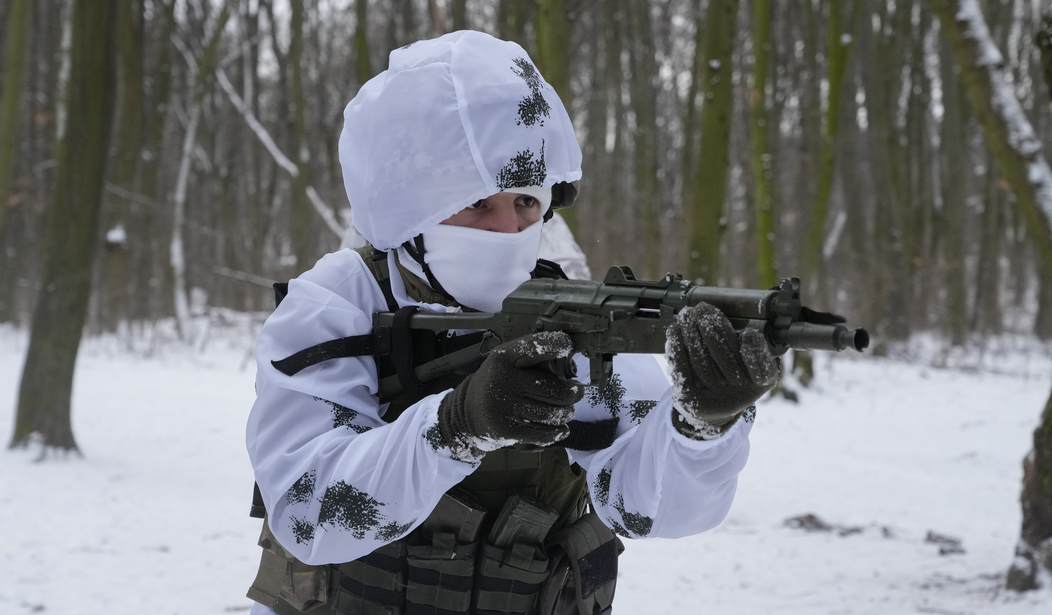The supposed WWII-era quote by Japanese Admiral Isoroku Yamamoto warning against an invasion of the United States because “there would be a rifle behind each blade of grass” may be apocryphal, but there’s plenty of truth in the statement no matter who came up with it, and the idea of armed citizens serving as a check on foreign aggression or domestic tyranny isn’t limited only to the United States.
In Myanmar, for example, civilians opposed to the military takeover of the government in February of 2021 are increasingly arming themselves in self-defense against the state, even as the ruling junta burn their homes and massacre those trying to flee its state-sponsored violence.
And in Ukraine, guns are becoming increasingly popular as Russia masses troops on the country’s eastern border. Despite the country’s restrictive gun laws, as Radio Free Europe reports, there are plenty of Ukrainians arming up.
A nationwide survey conducted by the Kyiv-based Razumkov Center in January found that 56 percent of Ukrainians believe that neither President Volodymyr Zelenskiy nor the authorities more broadly were “making sufficient efforts to prevent a full-scale invasion” or “organizing the country’s defense” for that eventuality.
Self-defense instructor Oleksiy Martynenko is another advocate of gun ownership, in part because “law enforcement can only do so much to protect everyone,” he said.
In his profession, he sees the growing number of “civilians considering gun ownership as a way of protecting their country,” Martynenko added.
Compounding concerns over the possibility of a new Russian invasion, he said, is the fact that “the majority of people [do not know] how to handle a weapon.”
Maratynenko cited the late Jeff Cooper, a former U.S. Marine and small-arms expert, as saying that “owning a gun doesn’t make you armed any more than owning a piano makes you a musician.”
RFE also covers a recent promotion from a chain of pizza restaurants in Ukraine owned by a veteran of the eight-year long conflict in eastern Ukraine where those who can show proof of purchase of a firearm or a gun permit can get a free pizza (dine-in only, unfortunately); a push that owner Leonid Ostaltsev says is about showing gratitude to new gun owners (and maybe encouraging some folks still on the fence to get a gun and training).
Still, even with the prospect of an invasion in the coming weeks, there are some Ukrainians who’d prefer people leave the fighting to the professionals.
Tetyana, an instructor in tactical medicine and first aid, sold her hunting rifle last year after being convinced it wouldn’t be effective in combat.
Most hunting rifles “are for short distances…and if a person has no experience in close-range or far-range shooting and never shot at a person before, then the weapon is more likely to put [the shooter] in a coffin,” she said.
Tetyana told RFE/RL’s Donbas.Realities that she is not opposed to civilians owning guns but that they must be kept in safe hands.
There are nearly 1.5 million firearms in circulation in the nation of 44 million, according to the Interior Ministry. About 70,000 are sold each year, the Ukrainian Arms Owners Association told the online publication New Voice of Ukraine this month, and it takes an average of one month to obtain a gun permit.
Vyacheslav Zhuravlyov, a former lieutenant colonel in the State Security agency’s anti-terrorist unit, is another advocate of responsible gun ownership, saying that there should be professionals to train how to properly handle weapons and everything else will be OK.”
Ukraine’s gun laws ban the possession of handguns and limit long guns to hunting rifles, but the war between the Russian-backed separatists and Ukrainian forces in the eastern part of the country has made it pretty easy for individuals to acquire modern weaponry, as long as they don’t mind going to the black market.
According to the Ukrainian photographer Andrey Lomakin, who photographed civilian gun owners in their homes, in 2014 and 2015, the insecurity and trauma of the war have made firearms in Ukraine a kind of “modern amulet,” awarding their owners “an extra power.” “Not everyone is comfortable to point it at the aggressor and shoot,” he has written. “But everyone feels safer having one.”
Lomakin, who is forty-three years old, grew up in Kiev, and remembers his schoolboy lessons in how to assemble a Kalashnikov rifle with his eyes closed, part of mandatory Soviet-era military training. Back then, Lomakin recalls, guns had a foreboding mystique—yet these days, he says, they have become alarmingly ordinary. He has seen a growing number of otherwise law-abiding citizens looking to buy guns, both legally and on the black market.
I can’t say that I blame them, though I think it would be much better for everyone involved if these gun owners didn’t have to resort to the black market, which may make them less likely to seek out real training once they’ve acquired a gun.
Ukraine’s government has taken some steps to create an organized militia of the people, but they’ve kept the existing gun laws in place, which means that the enlistees in the country’s 25 Territorial Defense Units are mostly using their own hunting rifles.
I’d say it’s long past time for the country to update its gun laws, not only to reflect the reality of potentially hundreds of thousands of otherwise law-abiding citizens who illegally possess arms for self-defense and defense of the nation, but to help ensure that those citizen-soldiers who have volunteered to defend their country can do so with something other than a bolt-action rifle. Hopefully these armed citizens won’t be called on to actually use their arms to defend their nation, but I’d say this is definitely a case of “better to have it and not need it than to need it and not have it.”








